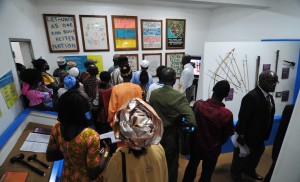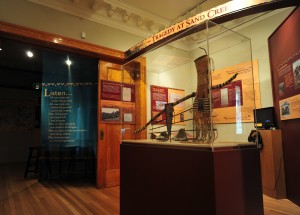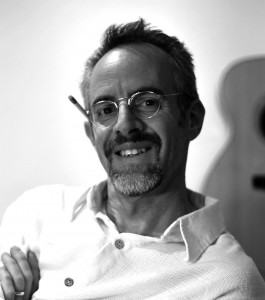Few stories are harder than the stories Seth Frankel ’93 designs and develops into exhibitions for museums across the country. As principal of his Colorado-based exhibition design firm, Studio Tectonic, he’s developed wide ranging exhibits. He’s created exhibits on watersheds, paleontology and beer (the beer and paleo exhibits aren’t the same, by the way, but he claims eyewitness account that there’s plenty of beer in paleo field camps).
But of the exhibits he develops, few are as challenging as the telling of human atrocity, genocide and healing. Some tell of recent events, such as his work creating the national Sierra Leone Peace Museum that wrestles with the nearly unspeakable genocide ending in 2002. Others are centuries old, such as the Civil War era Sand Creek Massacre of Arapaho and Cheyenne peoples in the Colorado Territory.

At the Sierra Leone Peace Museum, visitors look at the causes of the nation’s 1991 to 2002 civil war and how they connect to healing, rebuilding and promoting a continued peace.
“I strive to tell a balanced story. I use artifacts, media, visuals and narrative to provide the complexity of these human events in ways that the visitor can’t turn away from. It’s easy to dehumanize history’s perpetrators, but ultimately if we allow the richness of experience to grow in the visitor’s mind they’re engaged – not as observers but as partners in the humanity.”, says Seth.
In his twenty years of working with museums he’s seen significant growth in the relationship between storyteller and visitor. “Museums of the past, and many of our still standing older exhibits, have great objects and may be quite successful in disseminating facts. Who doesn’t enjoy seeing wonderful, powerful things?”, he asks. “But facts are quickly forgotten or replaced with new details. Building experiences, and our participation in creating and sharing these experiences, are very much at the center of the new museumship.”

Chief Niwot ~ Legend and Legacy exhibit the Boulder History Museum in Colorado challenges visitors to look at past atrocities against native peoples and asks them to consider their place today in relationship to this past.
Seth has observed changes also in the expectations of the public. Many of his exhibitions feature creating learning environments in which the visitor can both leave their mark for other exhibit goers and to the broader world through social media. In thinking about the importance of museums for promoting peace, Seth takes this work very personally.
“We commemorate and tell of horrible pasts…hopefully arriving at overcoming these horrors to arrive at decency and celebration of human compassion. Yet, we’re seemingly programmed to look for a happy ending. But peace museums aren’t about an ending…they’re about building the capacity to envision a future. One that can only exist through connecting ourselves to the breadth and range of the human condition. Our good. Our bad. Our forgotten. Our remembered.”
Want to see Seth’s work in person? Check out the list of exhibitions by Studio Tectonic and see if there’s one in your area.


